Contents
On top of the many coconut health benefits, the coconut tree or palm is a verifiable survivor. It has the innate ability to bow before the immense power of tropical cyclones without losing its hold on the ground. And when the storm has passed, these elegant trees stand tall on the tropical beaches as if nothing had happened.

Amazingly, their fruit, the coconut, can ride the ocean waves for hundreds of, even thousands of miles, without losing its ability to germinate. How vitally indomitable these seemingly fragile trees are. In 1840, a ship transporting coconuts sank in the Caribbean several hundred miles from the coast of Florida in the United States. The coconuts floated on the currents until they reached that state’s beaches. There they sprouted, producing beautiful forests of coconut palms that remain there.
In Sanskrit, the dialect of ancient India, the coconut palm is called Kalpa vriksha, which means “the tree that provides everything essential for life.” And this is not an exaggeration. It is well known that the inhabitants of the islands of Polynesia have survived, sometimes for generations, based on the coconut.
Coconuts provide liquid for drinking and solid food; their fiber is used for everything from ropes to toothbrushes. Palm trunks and fronds are used for sandals, textiles, and houses. The vital strength and resistance of the coconut and the palm’s flexibility seem to proclaim this unique fruit’s medicinal properties.
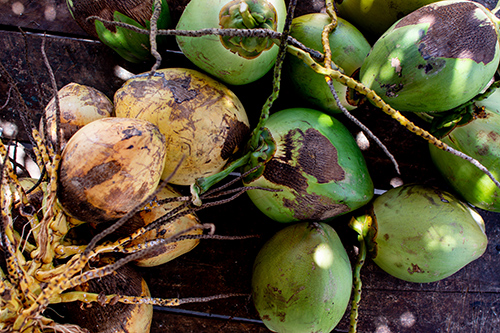
Coconut Nutritional Facts
The composition of coconut pulp varies with its degree of ripeness. When the fruit is green (six to seven months), the pulp is gelatinous, contains much water, and has less nutritional content. As the coconut matures, the pulp becomes firmer, with less water and more concentrated nutrients. It contains a fair proportion of carbohydrates, proteins, and mineral salts, especially calcium, phosphorus, and magnesium.
However, the most plentiful nutrient in the coconut is fat, which makes up more than a third of its mature weight. Nearly all of the fatty acids that make up coconut fat are saturated. However, there is a particular type of saturated fatty acids called short and medium chains, which do not promote cholesterol production in the body, in contrast to the long-chain saturated fatty acids from animal sources. Additionally, the coconut’s fatty acids are absorbed and assimilated quite well.
Therefore, it is inaccurate to say that coconut fat raises cholesterol, as once thought. This notwithstanding, coconut fat or oil should be used moderation, as with any other oil. The dietary and therapeutic properties of the coconut depend on its mineral content, particularly magnesium. Ripe coconut pulp contains 32 mg/100 grams, and coconut water contains 25 mg/100 grams. Although these are not large quantities, they surpass that of all animal-based foods, including meat, fish, milk, and eggs.
Most of the body’s MAGNESIUM is found in the bones and the muscles. It contributes to bone hardness and healthy cartilage in the joints. Lack of magnesium in the muscles produces cramps and nervous excitability. In addition to a certain amount of magnesium, coconuts contain other minerals of great significance to the musculoskeletal system, such as phosphorus and calcium.
Food such as coconut, which properly provides these minerals, contributes to healthy bones, joints, and muscles, all of which comprise the musculoskeletal system.
Coconut Health Benefits
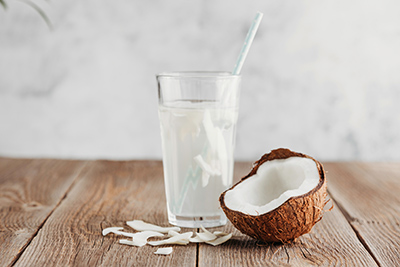
Coconut use (pulp or water) has a favorable impact on the musculoskeletal system in the subsequent cases:
1. Coconut health benefits (Decalcification of the bones) calcium loss.
2. Coconut health benefits (Osteoarthritis) deterioration of joint cartilage.
3. Coconut health benefits (Osteoporosis) loss and demineralization of bones.
4. Coconut health benefits (Musculoskeletal pain) is caused by excess tension or lack of muscular relaxation, primarily back pain.
Thanks to the coconut’s remineralizing effect, they are also recommended for the following:
5. Coconut health benefits (During infant teething), promote healthy enamel.
6. Coconut health benefits (In cases of brittle nails or hair).
It is fascinating that coconut milk or water is almost as rich in minerals as the pulp itself, but with the benefit that it comprises no fat. A liter of coconut water contains about 300 mg of magnesium, the RDA (Recommended Dietary Allowance) of this mineral for adults.
Coconut Scientific Facts
- Scientific name: Cocos nucifera L.
- Other names: Cokernut.
- French: Noix de coco.
- Spanish: Coco.
- German: Kokosnuss.
- Description: Seed of the coconut palm, a tree of the botanical family Palmae that reaches 65 feet in height. Despite its name, the fruit is botanically not a nut but a drupe that weighs up to 5.51 pounds (about five pounds). The coconut comprises a rough yellow or orange exterior husk, a fibrous intermediate layer equivalent to the fleshy part of common fruits. The central core, which contains the seed, is formed of the white pulp that is the edible portion.
- Environment: Coconuts are from the tropical and subtropical islands of the Pacific Ocean. Their cultivation has spread throughout Central America, the Caribbean, and tropical Africa.
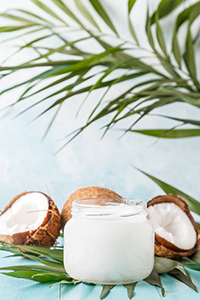
How to make Coconut Milk
Coconut milk is obtained by squeezing grated ripe coconut pulp.
- Finely grate the coconut pulp or put it in a blender.
- Add half a liter of boiling water and let stand for half an hour. Cow’s milk may be used in place of water.
- Prepare a cotton cloth and fill it with coconut paste.
- Twist the cloth containing the paste until all the liquid has been removed.
- To fully utilize the coconut, the hot water process may be prepared with the remaining pulp by repeating steps three and four.
- Coconut milk is a soft drink added to fruit shakes or other dishes.
Tips on How to Open a Coconut
Coconut water is a remineralizing beverage, ideal for quenching the thirst for tropical heat. It contains glucose and abundant mineral salts, particularly magnesium, calcium, and phosphorus.
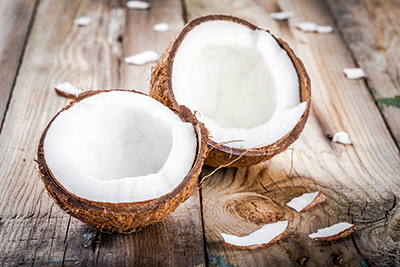
- Before anything, shake the coconut to see if it contains water. The coconut is dry or overripe if there is no typical sloshing sound. Under these conditions, the pulp is usually rotten.
- Make two holes in the “eyes” on the top of the coconut. You can do this with a hammer and nail or a corkscrew.
- Pour the water into a glass.
- Saw the coconut.
- Separate the shell from the pulp using either of these methods:
– Breaking the shell with a hammer
– Placing the coconut in a hot oven for a few minutes - Remove the brown skin adhering to the pulp, as it is indigestible.
- Wash the pulp in running water to remove any residue.
Composition of Coconut Oil (Fat)
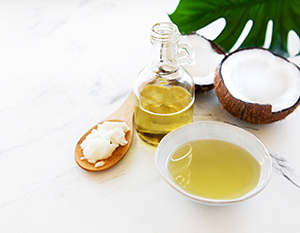
Most of the coconut’s fatty acids are saturated, which led many nutrition specialists to believe that they promote cholesterol formation, as is the case with the saturated fatty acids found in animal-based fats. However, most of the coconut’s fatty acids have a unique property that differentiates them from those of animal origin:
Their molecule contains from six to fourteen carbon atoms. Today, it is known that these short and medium-chain fatty acids found in coconuts do not increase cholesterol levels despite being saturated. Animal fats are predominantly long-chain saturated fatty acids such as stearic acid (18 carbon atoms) that increase cholesterol levels in the body.
| Fatty acid | Carbon atoms | Type | Proportion |
| Caproic acid | 6 | Sat. | 0.6 |
| Caprylic acid | 8 | Sat. | 7.4 |
| Capric acid | 10 | Sat. | 5.9 |
| Lauric acid | 12 | Sat. | 47.2 |
| Myristic acid | 14 | Sat. | 18.6 |
| Palmitic acid | 16 | Sat. | 9 |
| Stearic acid | 18 | Sat. | 5.5 |
| Oleic acid | 18 | Monounsat | 4.6 |
| Linoleic acid | 18 | Polyunsat | 1.2 |
Coconuts From Other Palms
Various types of tropical palms also produce fruits similar to coconut.
Sea coconut or Seychelles coconut (Lodoicea maldivica)—This enormous coconut may weigh up to 55 pounds. It is similar to the common coconut. It is grown in Madagascar and on other islands of the Indian Ocean.
King coconut (Cocos nucifera var. aurantiaca) – This yellow or orange variety of the typical coconut contains less pulp but much more water (up to one-half liter). The water of this coconut is more aromatic and refreshing than the common coconut.
Beach palm (Bactris major Jacq.) – This is the fruit of a palm that reaches 98 feet in height and grows wild. They are also cultivated in Panama, Columbia, and Venezuela. The fruits are yellow and grow in enormous bunches of up to 4000 pieces. The pulp has a bittersweet taste. It extracts a delightful juice for soft drinks, gelatins, and jams.
Peach palm (Bactris gasipaes L.)
Salak (Salacca edulis Reinw.) – This palm, which reaches 16 feet and has large fronds, is cultivated in Indonesia and Thailand. The fruit is remarkable because the shell is covered with scales reminiscent of a snake. The pulp, divided into three sections, is white, of firm consistency, and has a bittersweet taste. It acts as an astringent.
How to Use and Prepare Coconut
- Ripe pulp – This may be eaten raw, whole, grated, or roasted, forming part of various dishes.
- Gelatinous pulp – This is obtained from green coconuts. It is eaten with a spoon once the nut has been opened. It includes the same nutrients as ripe coconut but in lower concentrations.
- Coconut water – This is the liquid found inside the coconut. The greener the fruit, the more water there is. Coconut water is an excellent thirst quencher.
- Coconut milk – Refreshing and nutritious. Its preparation is described above. It may be made by adding water or cow’s milk.
- Copra – This is sun-dried coconut pulp.
- Coconut oil – This is prepared industrially by processing copra under high pressure.
DISCLAIMER: All content on this website is presented solely for educational and informational objectives. Do not rely on the information provided as a replacement for advice, diagnosis, or treatment from a qualified medical expert. If you are pregnant, nursing, or have any preexisting medical concerns, talk to your doctor before using any herbal or natural medicines.
REFERENCES
- George D. Pamplona-Roger, M.D. “Encyclopedia of Foods and Their Healing Power.” George D. Pamplona-Roger, M.D. Encyclopedia of Foods and Their Healing Power. Trans. Annette Melgosa. Vol. 2. Chai Wan: Editorial Safeliz, 2005. 325, 326, 327, 328. Print.
- Lauric Acid: https://pubmed.ncbi.nlm.nih.gov/12498139
- Antimicrobial Properties: https://pubmed.ncbi.nlm.nih.gov/22552175
- MCTs and Insulin Sensitivity: https://pubmed.ncbi.nlm.nih.gov/15123336
- Coconut Oil and HDL Cholesterol: https://pubmed.ncbi.nlm.nih.gov/19437058
- MCTs as Energy Source: https://pubmed.ncbi.nlm.nih.gov/11233403
- Journal of the International Society of Sports Nutrition: https://jissn.biomedcentral.com/articles/10.1186/1550-2783-9-5
- MCTs and Alzheimer’s: https://pubmed.ncbi.nlm.nih.gov/26798446
- Lauric Acid and Acne: https://pubmed.ncbi.nlm.nih.gov/21528434
- Coconut and Gut Microbiota: https://pubmed.ncbi.nlm.nih.gov/28821289
- Healthline: https://www.healthline.com/nutrition/coconut-meat
